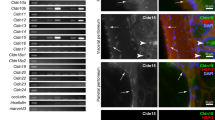Abstract
Pleural Malignant Mesothelioma (MM) is a fatal disease that has been associated with asbestos exposure. Differential diagnosis between the pleural infiltration of pulmonary carcinomas and MM is rather difficult particularly for epitheloid type mesothelioma.We aimed to investigate the utility of CD90, a cancer stem cell marker, in the differential diagnosis of MM and lung carcinoma, its prognostic significance and compare its value with that of Calretinin. Ninety pathology specimens including MM (n:30), pulmonary adenocarcinoma (n:30) and pulmonary squamous cell carcinoma (n:30) were used in this study. Immunohistochemical comparision of CD 90 and Calretinin was made in all groups. Calretinin was positive in 20 cases with MM (64.5 %), and was negative in 10 (32.3 %). CD 90 was positive in 25 of these cases (80 %) and negative in 5 (16 %). On the other hand pulmonary adenocarcinomas and squamous cell carcinomas showed positivity with CD90, 63,6 % and 73 %, respectively. We think that CD 90 has no place in the differential diagnosis between mesothelioma and pulmonary carcinoma because of the low specificity in spite of the high sensitivity.

Similar content being viewed by others
References
Gueugnon F, Leclercq S, Blanquart C et al (2011) Identification of novel markers for the diagnosis of malignant pleural mesothelioma. Am J Pathol 178:1033–1042
Panel V, Vyberg M, Weinreich UM et al (2015) The established and future biomarkers of malignant pleural mesothelioma. Cancer Treat Rev 41:486–495
Ascoli V (2015) Pathologic diagnosis of malignant mesothelioma: chronological prospect and advent of recommendations and guidelines. Ann Ist Super Sanita 51(1):52–59
Ucer O, Dagli AF, Kılıcarslan A et al (2013) Value of glut-1 and Koc markers in the differential diagnosis of reactive mesothelial hyperplasia, malignant mesothelioma, and pulmonary adenocarcinoma. Turkish J Pathol 29:94–100
Travis WD, Brambilla E, Müller-Hermelink HK, Harris CC (eds) (2004) World Health Organization classification of Tumours. Pathology and genetics of tumors of the lung, pleura, thymus and heart. IARC Press: Lyonn
Kawamura K, Hiroshima K, Suzuki T et al (2013) CD 90 is a diagnostic marker to differentiate between malignant pleural mesothelioma and lung carcinoma with immunohistochemistry. Am J Clin Pathol 140:544–549
Amatya VJ, Takeshima Y, Kohno H et al (2009) Caveolin-1 is a novel immunohistochemical marker to differentiate epithelioid mesothelioma from lung adenocarcinoma. Histopathology 55:10–19
Cassoni P, Daniele L, Maldi E et al (2009) Caveolin-1 expression in lung carcinoma varies according to tumor histotype and is acquired de novo in brain metastases. Histopathology 55:20–27
Zieglee A, Cerciello F, Bigosch C et al (2012) Proteomic surface some analysis of mesothelioma. Lung Cancer 75:189–196
Yilmaz G, Akyol G, Cakir A et al (2014) Investigation of diagnostic utility and expression profiles of stem cell markers (CD 133 and CD 90) in hepatocellular carcinoma, small cell dysplasia, and cirrhosis. Pathol Res Pract 210:419–425
Hermann PC, Bhaskar S, Cioffi M et al (2010) Cancer stem cells in solid tumors. Semin Cancer Biol 20:77–84
Ji J (2012) Wang Xw. Clinical implications of cancer stem cell biology in hepatocellular carcinoma. Semin Oncol 39:461–472
Deniz H, Kibar Y, Guldur ME et al (2009) Is D2-40 a useful marker for distinguishing malignant mesothelioma from pulmonary adenocarcinoma and benign mesothelial proliferations? Pathol Res Pract 205:749–752
Chaouche-Mazouni S, Scherpereel A, Zaamoum R et al (2015) Claudin 3, 4, and 15 expressions in solid tumors of lung adenocarcinoma versus malignant pleural mesothelioma. Ann Diagn Pathol 19:193–197
Yaziji H, Battifora H, Barry TS et al (2006) Evaluation of 12 antibodies for distinguishing epithelioid mesothelioma from adenocarcinoma: identification of a three-antibody immunohistochemical panel with maximal sensitivity and specificity. Mod Pathol 19:514–523
Ordonez NG (2006) The diagnostic utility of immunohistochemistry in distinguishing between epithelioid mesothelioma and squamous carcinoma of the lung: a comparative study. Mod Pathol 19:417–428
Yang ZF, Ho DW, Ng MN et al (2008) Significance of CD 90+ cancer stem cells in human liver cancer. Cancer Cell 13:153–166
Author information
Authors and Affiliations
Corresponding author
Rights and permissions
About this article
Cite this article
Sahin, N., Akatli, A.N., Celik, M.R. et al. The Role of CD90 in the Differential Diagnosis of Pleural Malignant Mesothelioma, Pulmonary Carcinoma and Comparison with Calretının. Pathol. Oncol. Res. 23, 487–491 (2017). https://doi.org/10.1007/s12253-016-0135-9
Received:
Accepted:
Published:
Issue Date:
DOI: https://doi.org/10.1007/s12253-016-0135-9




